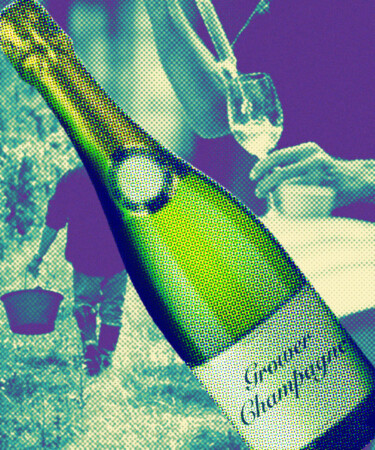As a big-ticket item, there can be a lot of pressure when it comes to buying the perfect bottle of Champagne. The intimidation factor and some powerhouse marketing strategies make it easy to default to bigger names like Veuve Clicquot, Louis Roederer, and Moët & Chandon. But there’s a lot more to this historic French region than the grandes marques. “Grower Champagne” is a burgeoning sub-category that also deserves your attention, and learning more about these wines can unlock a whole new level of bubbly to enjoy.
But when it’s tricky to explain the differences between Champagne, Prosecco, and Cava, how are consumers expected to decipher which bottles of Champagne fall under this distinct classification? Curious wine drinkers can always ask the wine pros at bars or shops for guidance. (Sommeliers, who tend to have an affinity for this category, might even appear overjoyed at the request.) But if you’re feeling lost in the sparkling wine aisle, there are certain signs to look for when seeking out a bottle of grower Champagne — or as it’s sometimes affectionately called, “farmer fizz” — that will help on your journey.
Read on to discover exactly what grower Champagne is, how to find it, and a few to look for the next time you’re at the wine shop.
What is Grower Champagne?
The definition of grower Champagne can be found in the name itself: the producers both grow the grapes and make the wine.
When shopping for a bottle of Champagne, people might assume that the winemaker only uses grapes grown on their estate. While this is the case for many producers across the globe, in Champagne it’s more common for big wineries to source grapes from a number of small farmers. At houses like Veuve Clicquot, the producers buy grapes from different growers across the region, then the winery is only responsible for the winemaking itself: vinification, blending, and aging. This is because these massive brands make so much wine that they require more grapes than any one farmer could grow. For example, the region’s largest producer, Moët & Chandon, makes about 30 million bottles per year.
On the other hand, with grower Champagne, the producer is involved in both aspects of the process, tending to their vineyards and crafting the wine from the grapes. By design, fewer of these wines are made, as they come from smaller producers who own and work with their own plots of vines.
So why do sommeliers love grower Champagne? It all boils down to the fact that these wines come from small-production, thoughtful vintners who pay close attention to detail in both the farming and wine production. This leads to beautifully expressive wines that often represent a specific terroir.
This doesn’t mean that Champagne from the larger houses is bad. And it’s clear that these brands have found great success making a consistent house style through masterful blending. But fans of farmer fizz enjoy knowing the hyper-specific micro-terroirs the wine is from, and experience that sense of place in the glass.
How Can I Find Grower Champagne?
Wine from the big houses accounts for over 90 percent of the region’s exports, so locating a bottle of grower Champagne can be tough. Not only because there are so few of them, but also because the term “grower Champagne” isn’t presented on the front label as an official classification like “grand cru” or “riserva.” Instead, there are specific signs to look for when you’re on the hunt.
The first strategy would be to learn a few well-known grower-producers that you can easily search for on shelves or online wine shops. Some wines, like bottles from Jacques Selosse, a pioneer in the grower Champagne movement, are highly allocated and expensive, so they’re a bit out of reach. But there are a number of great producers that are more widely available and carry a similar price tag to a typical bottle of Bollinger or Laurent-Perrier. Keep an eye out for wines from Bérêche & Fils, Frédéric Savart, Agrapart & Fils, and Pierre Peters. Some more that might be a bit more difficult to find, but are absolutely worth seeking out include Marie Courtin, Dhondt-Grellet, Egly-Ouriet, and Georges Laval.
Another approach is to pay close attention to the bottle. While there’s no specific labeling for grower Champagne, each producer has a registration number, a long alpha-numeric code listed in incredibly small, hard-to-read print somewhere on the bottle. While this might seem difficult to decipher, the sequence always starts with two letters — this is what you’re looking for. When the first two letters are “NM” this means that the winery bought at least some of the grapes in the wine from outside sources, and “CM” signals that the wines come from local co-ops. If the code reads “RM” (standing for récoltant manipulant, which translates to Grower Maker), this means the producer crafted the wine with only their own grapes. (This is what you’re looking for!)
Curious consumers can always consult a wine pro at any bar, restaurant, or shop as well, and they would be happy to point you in the direction of some delicious farmer fizz.
